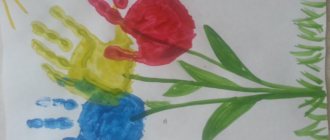Lesson summary: “Sand, stones, clay”
Lesson summary on the topic “Sand, clay, stone. Properties".
Goals:
Educational.
— to develop children’s cognitive and research activity in the process of forming ideas about the properties of sand, clay, and stone.
— teach how to compare materials, correctly name all the features in accordance with their properties, and use them in crafts.
- develop a “sense of time.” Introducing the hourglass.
Developmental.
- develop coherence of speech, visual attention, creative imagination.
— teach to observe, compare, analyze, classify, draw conclusions, make independent conclusions.
3. Educational
.
- formation of mutual assistance, goodwill, independence, initiative, responsibility, cooperation.
-instill in children accuracy and the ability to work with handouts.
Vocabulary work:
adjectives: hard, durable, free-flowing, dry, wet, viscous, binding
nouns: substance, property, magnifying glass.
Preliminary work:
observation of the properties of sand, clay, stone.
Examination of folk clay toys.
Manual and material:
-sand, clay and stones for each child, jars of water, plastic spoons, magnifying glasses, wooden sticks, aprons, lumps of wet clay.
GCD.
1. Introductory part.
Educator. Guys, we have a very interesting job today. It will take place in our children's “laboratory”. Let's imagine that we are "scientists". Who are scientists?
Children. People who study different subjects, conduct experiments, make discoveries, work with instruments
Educator. That's right, in our laboratory there are instruments that we have already worked with. And we, “scientists,” will conduct experiments, research, observations, and draw conclusions.
2. Main part.
Educator. You see natural material in front of you. Which?
Look and name.
Children. Clay, sand, stones.
Educator. Today we will compare materials in pairs - sand and stone, sand and clay, stone and clay. Let's look at and compare sand and stone. Touch the sand, play with it. What is he like, what can you say about him?
Children. The sand is dry and can be sprinkled.
Educator. To get a good look at it, take a magnifying glass and look through it. What do you see?
Children. Lots of small crumbs and grains of sand
Educator. That's right, sand is the smallest grains of sand, grains of destroyed stone. What kind of stone is it?
Children. It is hard, tough, smooth.
Educator. Now we will find out what is heavier, sand or stone. I will conduct an experiment, you watch carefully, and then conduct it yourself
I pour sand and stones into a jar of water and mix everything with a stick, watching how it settles to the bottom, what touched the bottom faster were the stones or the sand?
Just as you scientists yourself will now conduct the experiment, make observations and conclude what is heavier and what is lighter.
Take a jar of water, pour sand and stones into the jar, mix everything with a stick and see what you see, which touched the bottom faster, and why?
Children. Pebbles.
Educator. Why?
Children. Rocks are heavier than sand.
Educator. Now let's compare sand and clay.
Let's determine which allows water to pass through better. Take magnifying glasses, look at sand and clay, how do they differ from each other?
Children. Sand has many grains of sand, grains, but clay does not. It is dry, soft, like down.
Educator. Now I will conduct another experiment with sand and clay. You need to pour water into the glasses at the same time. Why at the same time? Our task is to determine whether sand or clay allows water to pass through faster: That’s why water needs to be poured at the same time. I take two jars with funnels, cover the holes in the funnels with a cotton pad, pour a spoonful of clay into the first funnel, and a spoonful of sand into the second funnel. Then, at the same time, I pour water from glasses into two jars up to the top onto the clay and sand, and see which jar fills the water faster.
Children. In a jar with sand.
Educator. Right, why? Who can answer?
Children. Sand allows water to pass through, but clay does not.
Educator. We made sure that sand allows water to pass through, but clay almost does not, since wet clay becomes viscous, sticky, it consists of tiny particles closely connected to each other, and it is good to sculpt from it. Now let's compare stone and clay. Let's clarify, what kind of stone?
Children. Heavy, hard, durable.
Educator. Guys, when clay dries, it turns into stone. See what happens when you press on a clay stone, what do you see?
Children. She fell apart.
Educator. And click on an ordinary stone. What happened to him?
Children. Nothing.
Educator. Why?
Children. Because the stone is durable and hard.
Educator. Children, you and I are convinced that the stone is hard, strong, durable. Because of its durability, stone is used in the construction of buildings. And many folk toys, crafts, whistles, and beautiful dishes are made from clay. And all this, sand, clay, and stone are called minerals. Who finds these minerals?
Children. Geologists.
Educator. Who are geologists?
Children. Geologists are people who look for minerals in the earth.
Physical education minute.
Educator. Now let’s imagine that we are “geologists” and will go in search of minerals. Maybe we'll get lucky today? (Children imitate movements, digging with a shovel, find clay.)
Educator. Guys, did you find something?
Children. Yes, clay.
Educator. What is clay?
Children. Mineral resource.
Educator. Why do we need clay, why is it useful?
Children. It is used to make toys, beautiful dishes, and is used in construction.
3. Summary of the lesson.
Well, today we were “scientists”, and “geologists”, and “researchers”; we learned about the properties of which minerals? (children's answers)
What have we learned about them, how are they useful? (children's answers)
Sand
Sand is a natural granular material consisting of small fragments of quartz, mica, spar and other minerals. It is formed due to the destruction of rocks under the influence of the environment.
There are many types of sand, but river and quarry sand are most often used in construction.
Features of river sand are:
- Lack of clay, which is necessary when building brick walls and creating screeds on the floor.
- High water permeability, therefore often used as a basis for drainage.
- It contains fewer impurities compared to other types of sand, which is why it is used for making glass.
River sand is also added to mixtures in the production of certain types of concrete, dry construction mixtures and mortars.
River sand contains smoother grains of sand compared to quarry sand, which makes quarry sand more suitable for concrete mixtures , since the uneven broken structure of its sand grains is stronger in connections with cement.
Unrefined quarry sand contains impurities, including clay, which gives it both advantages and disadvantages compared to river sand, depending on the type of construction work. Unrefined sand is rarely used, not for concrete work, since such a connection can be fragile due to various impurities in it, but it is actively used for backfilling (for example, to raise an area).
Quarry sand is used as a filler for concrete, in the production of reinforced concrete structures, as well as in the construction of highways and airfields. In the first case, it must be cleaned of impurities (mainly by washing), in the second case no cleaning is required.
Quarry sand is divided into seeded and washed - depending on the method of purification from impurities and larger fractions. Both types of sand preparation for construction remove soil, large as well as small dust particles, clay and other undesirable fractions.
The seeded sand is cleared of soil, large fractions, as well as dusty small particles. It can already be used for some types of concrete mixtures, for plastering work, and for laying foundations.
Washed sand is of higher quality than seeded sand, its characteristics are similar to river sand, it can also be used for wall masonry, screed, and concrete mixtures.
Sand also differs in the composition of its fractions - fine-, medium- and coarse-grained. Fine-grained sand is the most expensive sand, due to the high labor intensity of extraction, and is used for the manufacture of grouts and putties, self-leveling floors and other finishing materials. Coarse quarry sand is suitable for the production of paving slabs, curbs, for drainage, and is also used to create a cushion for the foundation.
Sea sand is as clean as river sand, but its extraction is not very active, as it requires much more labor. In addition, sea sand contains a significant amount of salts, which makes it unsuitable for a number of construction works. True, in countries where, apart from sea sand, there are no other types of it, the material is washed with fresh water, but this only increases the cost of the final product. However, sea sand is used quite often in construction, although not in the same way as other types of sand.
Pebbles, sand and crushed stone are indispensable assistants in the construction of all kinds of objects and structures. The correct choice of material for construction is the key to a durable structure or structure. Saving on the quality of sand can result in huge expenses for repairs in the future after cracks or damage occur.
Pay attention to the cost of sand - with delivery per cubic meter or not. The main part of the cost is delivery; do not forget also that it is more profitable to order a large batch of sand than to buy a couple of cubes, each time increasing the cost of sand due to transportation costs.
Pebbles
The scientific name for pebbles is tumbled stone . It is a collection of a wide variety of natural minerals and rocks (most often quartz, dolomite or granite), polished to small smooth stones with the assistance of natural assistants - water and wind. The peculiarity of pebbles is that they owe their variety of colors, shapes and strength only to nature; humans have virtually no influence on the process of their creation and formation.
Between different types of pebbles, depending on the water in which the centuries-long process of their formation takes place, there are several differences, often significant. When treated with sea water, pebbles become smoother, sometimes even mirror-like, due to the constant ebb and flow of the tides, as well as the high salt content, which together act as an abrasive stone. Due to their strength, the most valuable pebble stones are Black Sea and Adyghe.
Pebbles are used for the construction of foundations, the construction of runways and highways, using them as a “cushion” for these objects, since due to their small size and high strength, they can withstand very heavy loads. Pebbles are also considered the best material for laying drainage systems and for backfilling access roads to beginning construction.
But pebbles are most widely used as a decorative material, since they are beautiful, environmentally friendly and, thanks to the variety of colors and shapes, an original decoration for interiors and landscapes: fountains, gardens, parks, artificial ponds and flower beds. Not only the facades and plinths of buildings are decorated with pebbles. It is also used for interior decoration (for example, a bathroom, even a kitchen apron).


